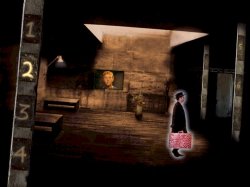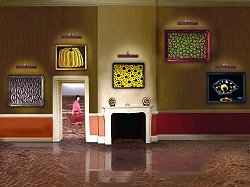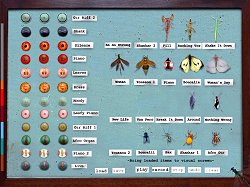|
Peter Gabriel's EVE
 A pastiche of sound and images, EVE is a multimedia experience that has a lot in common with Alice; An Interactive Museum and Ceremony of Innocence, another title from this stable. Instead of the written and spoken word of the latter, EVE utilises music to add substance and depth to interactive landscapes. Pieces of music written by Peter Gabriel are infused with the works of artists and the thoughts of the lonely hearted to create a kind of performance piece that may (or may not) be about aspects of the human condition.
A lot of effort clearly went into EVE. There are over 120 screens assembled from 22,000 photographs, 80 minutes of video and 45 minutes of specially written music. Art gives visual substance to the music, sound gives an aural quality to shape and pattern. Numerous experts, and not so experts, contributed their talent, their thoughts and their feelings, and the 58 page glossy book that accompanied my copy gave me a greater appreciation for the whole than I would have had otherwise.
The large number of video and sound clips are spread throughout a number of worlds, each one combining music and art and images to create a series of interactive scenes. Hotspots within each scene will elicit a response, some being more meaningful than others. Each scene will contain links to other scenes, and as hotspots are explored, more and more links will be available. Uncover all the hidden aspects of a world (or at least the important ones) and you will be able to access one of the other worlds. In this regard it is much like moving through the thematic rooms in Alice. A pastiche of sound and images, EVE is a multimedia experience that has a lot in common with Alice; An Interactive Museum and Ceremony of Innocence, another title from this stable. Instead of the written and spoken word of the latter, EVE utilises music to add substance and depth to interactive landscapes. Pieces of music written by Peter Gabriel are infused with the works of artists and the thoughts of the lonely hearted to create a kind of performance piece that may (or may not) be about aspects of the human condition.
A lot of effort clearly went into EVE. There are over 120 screens assembled from 22,000 photographs, 80 minutes of video and 45 minutes of specially written music. Art gives visual substance to the music, sound gives an aural quality to shape and pattern. Numerous experts, and not so experts, contributed their talent, their thoughts and their feelings, and the 58 page glossy book that accompanied my copy gave me a greater appreciation for the whole than I would have had otherwise.
The large number of video and sound clips are spread throughout a number of worlds, each one combining music and art and images to create a series of interactive scenes. Hotspots within each scene will elicit a response, some being more meaningful than others. Each scene will contain links to other scenes, and as hotspots are explored, more and more links will be available. Uncover all the hidden aspects of a world (or at least the important ones) and you will be able to access one of the other worlds. In this regard it is much like moving through the thematic rooms in Alice.
 There are 4 worlds, Mud, the Garden, Profit and Paradise. You may also encounter a fifth world, Ruin, between Profit and Paradise. Each world is represented by a scrolling screen illustrative of the particular world. Buildings in each world, such as the Human Relations room and the art galleries, are common to each one. You can explore those buildings, and what you find will be determined by what you have interacted with in the scenes. As you uncover more scenes, and more interactions, the buildings will contain more items. It pays to visit more than once, as access to some worlds require you to have found a lot of stuff.
The scenes within each world are generally single screens, and moving forwards will usually require you to work out how the particular interaction operates. Interacting with the scenes is much like it is in Ceremony of Innocence. You might simply click with your cursor and see the results. You might have to capture a glowing sphere, or grab a floating stick, or drag a railway carriage. You may have to purloin the butterfly net from a (naked) EVE and go on a bug hunt, or obtain a sledgehammer (a favourite tool of Mr Gabriel) and do a bit of remodelling. Clicking may elicit a different response to holding down the mouse.
Much of the time spent in each scene will be working out how the interactions work. You will go back and forth a lot, but there is a definite forward direction. After a while you will begin to be able to recognise the signs that will enable you to progress. There are rules too, and these you will need to work out as well. Repetition will be the name of the game early on, but as the rules become clear you will be able to navigate in a far more orderly way through the scenes and the worlds.
Each of the single screens is full size, but the scrolling screens are blank at top and bottom, like the "letterbox" format for movies on video or DVD. You may have to do something first in order to get the world screen to scroll.
Mr Gabriel himself appears quite often. In several scenes you can "capture" him with the mouse and make him dance rather like his namesake Mr Garrett. In many scenes he (or someone like him) has a suitcase and it is a good rule of thumb to do as Alice did and follow along.
You can save at will, and there is a very good help system on the CD cross referenced to each scene. If you are stuck, right click anywhere in the screen, and you will get a help menu which includes a number which you use to look up the answer on the CD. You have to exit the game to do this, unless you print the hint file from the CD. There are 4 worlds, Mud, the Garden, Profit and Paradise. You may also encounter a fifth world, Ruin, between Profit and Paradise. Each world is represented by a scrolling screen illustrative of the particular world. Buildings in each world, such as the Human Relations room and the art galleries, are common to each one. You can explore those buildings, and what you find will be determined by what you have interacted with in the scenes. As you uncover more scenes, and more interactions, the buildings will contain more items. It pays to visit more than once, as access to some worlds require you to have found a lot of stuff.
The scenes within each world are generally single screens, and moving forwards will usually require you to work out how the particular interaction operates. Interacting with the scenes is much like it is in Ceremony of Innocence. You might simply click with your cursor and see the results. You might have to capture a glowing sphere, or grab a floating stick, or drag a railway carriage. You may have to purloin the butterfly net from a (naked) EVE and go on a bug hunt, or obtain a sledgehammer (a favourite tool of Mr Gabriel) and do a bit of remodelling. Clicking may elicit a different response to holding down the mouse.
Much of the time spent in each scene will be working out how the interactions work. You will go back and forth a lot, but there is a definite forward direction. After a while you will begin to be able to recognise the signs that will enable you to progress. There are rules too, and these you will need to work out as well. Repetition will be the name of the game early on, but as the rules become clear you will be able to navigate in a far more orderly way through the scenes and the worlds.
Each of the single screens is full size, but the scrolling screens are blank at top and bottom, like the "letterbox" format for movies on video or DVD. You may have to do something first in order to get the world screen to scroll.
Mr Gabriel himself appears quite often. In several scenes you can "capture" him with the mouse and make him dance rather like his namesake Mr Garrett. In many scenes he (or someone like him) has a suitcase and it is a good rule of thumb to do as Alice did and follow along.
You can save at will, and there is a very good help system on the CD cross referenced to each scene. If you are stuck, right click anywhere in the screen, and you will get a help menu which includes a number which you use to look up the answer on the CD. You have to exit the game to do this, unless you print the hint file from the CD.
 Not surprisingly, music and sound play a big part in EVE. In fact, many of the interactions are keys to sound loops that you will be able to use to create your own musical pieces. There are three separate IMX (or Interactive Musical Xperiences) in EVE, one for each of 3 musical compositions. You will be able to mix and splice the sound loops in any way you choose, through a very user-friendly visual interface.
There are background (or mood) music loops, which are akin to the accompanying instruments, and flyins, which are the lead instruments or vocals. For each song there are 12 background loops and 18-21 flyins. Some are available by default, but many are hidden throughout the worlds of EVE, and will only be available if you have found them. They will be visually depicted on the interface, so you will be able to see how many (or how few) you have found.
Having joined some musical loops together, you can then play them against a graphic background. More than that, the moods you have chosen in the music are indicated by objects in the background screen, and changing moods is done by clicking those objects. As you change moods, the background changes in time to the music. Flyins will appear as still or animated objects that you also play by clicking on them. When you have finished, you can save your creations, and even share them with others. It all sounds a bit chaotic, but the result is quite impressive, all the more so because you created it. Not surprisingly, music and sound play a big part in EVE. In fact, many of the interactions are keys to sound loops that you will be able to use to create your own musical pieces. There are three separate IMX (or Interactive Musical Xperiences) in EVE, one for each of 3 musical compositions. You will be able to mix and splice the sound loops in any way you choose, through a very user-friendly visual interface.
There are background (or mood) music loops, which are akin to the accompanying instruments, and flyins, which are the lead instruments or vocals. For each song there are 12 background loops and 18-21 flyins. Some are available by default, but many are hidden throughout the worlds of EVE, and will only be available if you have found them. They will be visually depicted on the interface, so you will be able to see how many (or how few) you have found.
Having joined some musical loops together, you can then play them against a graphic background. More than that, the moods you have chosen in the music are indicated by objects in the background screen, and changing moods is done by clicking those objects. As you change moods, the background changes in time to the music. Flyins will appear as still or animated objects that you also play by clicking on them. When you have finished, you can save your creations, and even share them with others. It all sounds a bit chaotic, but the result is quite impressive, all the more so because you created it.
Art also plays a large part, and you will find and explore many pieces, as well as hear from the artists themselves and view videos of them working. Four visual artists each worked on one particular piece of music, the whole then being deconstructed and spread throughout each of the worlds (not Ruin). In essence, you get to put it back together as described above.
I confess I actually found the IMX and its components the best bit, and I am in no way a musician. After the first few insights I could not have cared less about the relationship snippets emanating from the lonely hearts house, nor from the experts around the place, so I stopped paying attention to them. And whilst I quite enjoyed poking around in the scenes working out the interactions, some of the rules made this unnecessarily repetitious, so much so in some instances that I couldn't be bothered looking anymore and moved on.
As I was far more taken with the music and images than I was with the spoken word, some of the more subtle insights or reflections may have passed me by. The worlds are clearly thematic, and much of the progression and imagery is indicative of the march and development of humanity, both good and bad, social and psychological. The names of the worlds themselves suggest what this piece is about. But I may have missed a deeper thesis. Not that it needs to be deep. Or that I needed to find its depth. Each to his or her own. If it gives you a worthwhile experience then it matters not if that experience is different to mine or that of the makers.
Peter Gabriel describes EVE thus: "We selected and created many different elements, using both the songs and the artists work, and put them together in a sort of playpen. EVE is full of visual and musical playthings to mess about with which can, with time, be put together and taken apart to produce something satisfying".
So whilst it is not a game in any but the most limited sense, EVE will probably hang around on my hard drive for a while, and I expect I will dip in and out of it. I haven't exhausted myself looking for things yet, and I haven't nearly tired of the IMX. Maybe Peter would be pleased.
Copyright © Steve Ramsey 2002.
All rights reserved.
System Requirements:
Windows 95, 486/66 Mhz processor, 8 Mb RAM (16Mb recommended), 10Mb disc space, 2x CD ROM, 16 bit colour graphics at 640 x 480 resolution, Sound Blaster 16 compatible sound card, Quicktime 2.1 (included)
Macintosh 68040 @ 33 Mhz, System 7.1, 8 Mb RAM (12Mb recommended), 10Mb disc space, 2x CD ROM, 16 bit colour graphics at 640 x 480 resolution, Quicktime 2.1 (included), Sound Manager 3.2 (included)
|
